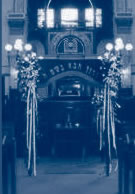|
SEDRA : Behar Hertz Chumash p. 521 Leviticus
Chap. 25
This week's Sedra is generously sponsored by Meier Heilbrunn.
SYNOPSIS:
The cycle of Sacred seasons begun in Sedra Emor is now completed
with the system of the Sabbatical Year and the Jubilee.
After taking possession of the land of Israel, the Israelites
were to observe every seventh year as a Shemittah (Sabbath)
year for the land. The land was to lie fallow; the fields
were not to be sown, the vineyards not pruned and no reaping
(of produce that grew by itself) was to take place. The land
is not man's absolute possession : "...for the land is
Mine; for you are strangers and settlers with Me." (verse
23). The land belongs to G-d, and is held in trust for His
purposes.
Every fiftieth year would be Yovel (Jubilee) and would be
proclaimed on Yom Kippur. During this year too, the land could
not be sown. In addition all Hebrew slaves were to be set
free and all lands previously sold were to revert back to
the original possessors. The price of land was based on the
number of years remaining till the Yovel. Land that was sold
because of its owner's poverty could (should) be redeemed
by a relative or by the original owner himself.
A house in a walled city could be redeemed within one year
of sale. After one year it became the permanent possession
of the buyer. Houses in villages and in the cities of the
Levites, however, could not be sold in perpetuity, but reverted
to the original owner in the Yovel year.
One should lend money to an indigent fellow Jew without charging
him interest. If a poor Jew was forced to sell himself into
servitude (a form of insolvency) his Jewish master must treat
him with respect and consider his rights - as if he were a
hired servant. After six years he may go free; but if he insists
on remaining in servitude he cannot be kept beyond the Yovel.
The Jew could (should) be redeemed by a relative by reimbursing
the master a sum based on the number of years remaining until
the Yovel.
HAPHTORAH HERTZ CHUMASH P.551 Jeremiah Chap 16 : 19
The Sedra speaks of the disasters which will be visited upon
the Jewish people if they defy G-d. Jeremiah was a witness
to the destruction of the Temple and the exile of his people.
Here Jeremiah, acknowledging their punishment and low state,
nevertheless preaches a message that : "G-d is the Hope
of Israel" (17 : 14) if only Israel would turn to G-d
and ask to be healed and saved.
TELL ME RABBI ..... THE SECOND AMIDAH BLESSING POWERS
"GEVUROT"
In the second Amidah blessing, we extol G-d's greatness in
giving life, in restoring life, in providing the necessities
of life. We mention His awesome powers over all creation,
in conformity with the verse from Psalms 29:1: "Ascribe
unto the Lord glory and strength" (Megillah 17b). In
doing so, we also imply the dependence of nature and all living
things on G-d.
TEXT (Artscroll page 462) "You, O Lord, are mighty for
ever; You revive the dead; You have the power to save. You
sustain the living with lovingkindness, You revive the dead
with great mercy. You support the failing, heal the sick,
set free the bound, and keep faith with those that sleep in
the dust. Who is like You, O Master of mighty deeds? Who resembles
You - a King who puts to death and restores to life, and causes
salvation to flourish? And You are sure to revive the dead.
Blessed are You - the Lord, who revives the dead".
Power is generally defined in terms of one's ability to destroy.
We do not so define G-d's power. We emphasise that the real
might of G-d lies in His ability to give life to man and to
earth, to sustain life, to heal the sick, to free the captive,
to raise the fallen. We focus here on G-d's powers in terms
of His acts of "loving kindness" (hesed), by helping
man when he is helpless.
The Jewish concept of loving kindness ("hesed")
for the dead by providing them with proper burial and treating
their bodies in a dignified way is called a hesed shel emet
("a true act of loving kindness") since there can
be no reciprocity attached to this selfless act. Even the
High Priest, who was forbidden any contact with the dead,
unable even to take part in the burial of his own parents,
was required to defile himself to perform this hesed shel
emet if he came upon an unburied corpse. The greatest expression
of G-d's loving kindness is therefore what He can do for the
dead.
The thrice-repeated emphasis in this blessing on "making
the dead to live" or "reviving the dead" reflects
an ancient controversy with the Samaritans, the Sadducees
and others, who denied this belief (Sanhedrin 10:1; Rosh Hashanah
17a). The Talmud, however, declares that G-d will make the
dead to live again (tehiat hameitim) a doctrine so central
to Jewish life that its denial is deemed a heresy for which
one forfeits a share in the world-to-come.
Maimonides (1135-1204) includes it among his thirteen principles
of faith because, aside from creation, it is the ultimate
expression of Divine power (though not necessarily the ultimate
spiritual reward). If G-d was able to create (from nothing)
that which had never existed, He can certainly recreate that
which had already existed.
Still, the precise meaning of this principle of faith remained
open to legitimate controversy.
Though a prayer for rain properly belongs in a blessing for
economic sustenance and, in fact, does appear there, rain
is also mentioned in this blessing as yet another example
of G-d's power to "make the dead to live" - which
is the central theme of this blessing. For through rain, G-d
brings the barren and "dead" earth back to life
and to fruitfulness.
Rain is mentioned in the passage only during the winter months
(from Shemini Atzeret until the first day of Pesach) since
this is the time that it is needed in Eretz Yisrael. Mention
of rain is omitted during the summer months when it could
ruin the crops (Sam. 1, 12: 17-18, Rashi). During the summer
season, mention of "dew" (morid ha-tal) may be substituted
for that of rain.
BACK TO SHABBAT SHALOM
TABLE
|








